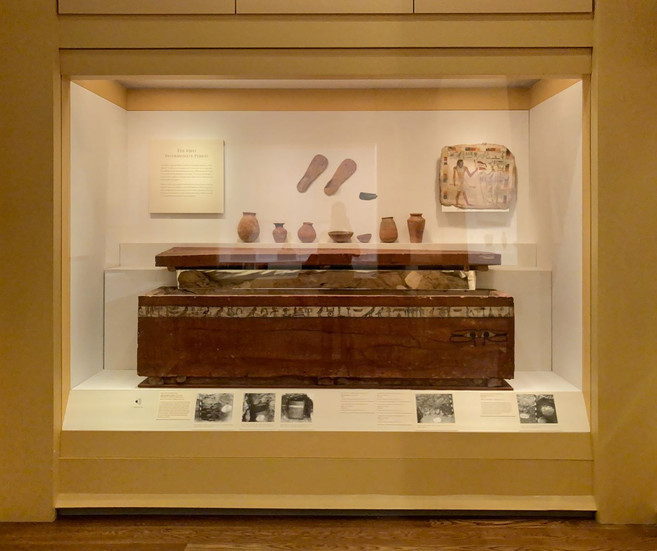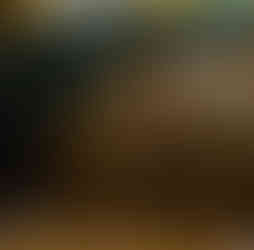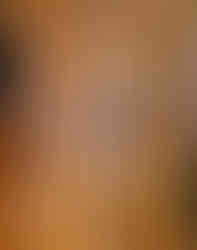Mummies
- Brenna Reistad
- Apr 18, 2024
- 3 min read
Coffin of Tjeby
Coffin and Mummy of Tjeby
Egyptian
ca. 2051-2030 BC
Painted wood with linen-wrapped mummy
53.30.1
This coffin, like many wooden objects from ancient Egypt, consists of small pieces of wood that have been pegged together. The single line of text decorating the coffin’s lid and chest records Tjeby’s name and titles (Count and Sealbearer of the King of Lower Egypt) as well as prayers to protect him in the afterlife. Tjeby’s mummy was placed on its left side so that he could look out through the wadjet eyes painted on the exterior. The wadjet or Eye of Horus (the falcon god), was often used to ward off evil; the two eyes here served to protect Tjeby on his journey through the underworld.
Inner Coffin of the Charioteer Iotefamun
Egyptian
Inner Coffin of the Charioteer Iotefamun
ca. 1070-945 BC
3rd Intermediate Period
27th Dynasty
painted plaster over wood
L.7.47.72
On loan from The Metropolitan Museum of Art
Beginning about 2000 BC, funerary masks on some mummies were extended to cover the entire figure, creating an inner coffin in the form of a human body. By about 1200 BC, mummies frequently rested in several coffins nested together. A chariot whip was found in this burial, identifying the profession of the deceased.
From the Metropolitan Museum
The coffin set of the General’s Charioteer, Iotefamun (an outer coffin (26.3.1a, b), this inner coffin, and a mummy board (26.3.3)) was found in a reused tomb in a valley south of Deir el-Bahari. Iotefamun’s outer coffin was not completely closed, as this coffin, made originally for a priest and copper engraver of the temple named Nesiamun, was slightly too large.
The layout and decoration of the lid is similar to that of the outer coffin, with the deceased in a tripartite wig with floral fillet, elegant features and large ears, and hands fisted over the chest. A winged figure of Nut again divides the upper and lower parts of the lid. In this case, the space above contains a djed pillar flanked by deities in human form; the lower part is divided by bands of inscription into 10 symmetrical sections containing illustrations from Egyptian mythology. Additional illustrations adorn the sides of the box. In contrast to the outer container, this coffin has been varnished.
Outer Coffin of the Charioteer Iotefamun
Egyptian
Outer Coffin of the Charioteer Iotefamun
ca. 1070-945 BC
3rd Intermediate Period
27th Dynasty
Wood, gesso, paint
26.31a.b
On loan from The Metropolitan Museum of Art
From the Metropolitan Museum
The coffin set of the General’s Charioteer, Iotefamun (this outer coffin, with an inner coffin (26.3.2a, b), and a mummy board (26.3.3) was found in a reused tomb, where earlier burials had been robbed and pushed aside. Iotefamun’s coffins were set against one wall, with his canopic box resting on the lid of the outer coffin. The lid of this coffin was not completely closed, as the inner coffin, made originally for a priest and copper engraver of the temple named Nesiamun, was slightly too large. Inside the coffin set was the mummy, which had been wrapped in linen and then covered from waist to feet with a soft hide, perhaps from a gazelle, and a whip (26.3.2a, b)
The style of this anthropoid coffin is typical of the earlier 21st Dynasty. Iotefamun wears a long tripartite wig bound with a floral fillet. His features are fine, with arched brows and long cosmetic lines outlining his wide-set eyes. Earring holes are visible on his exposed earlobes. His arms are crossed over his chest on top of a broad festival collar, with his hands fisted. A winged figure of the sky goddess Nut is shown kneeling at the level of his abdomen, with the space above filled by the icon of a djed pillar, symbol of the funerary god Osiris, flanked by crowned falcons, winged cobras, and recumbent cows. The lower portion of the lid is divided by horizontal and vertical bands of inscription into six sections, each filled with an illustration relating to Iotefamun’s afterlife. On the sides of the base, again divided by inscriptions, are various funerary deities. The inside is undecorated. Unusually for this period, the outer surface of this coffin has not been varnished.
Mummy Cartonage (Mask)
Egyptian
305-30 BC
Ptolemaic Period (332-30 B.C.)
Painted gesso over wood
69.72
Preserving a likeness of the deceased was important in the Egyptian funerary cult. Masks like this one protected the head and were acceptable substitutes if the mummy was damaged.
































































Comments